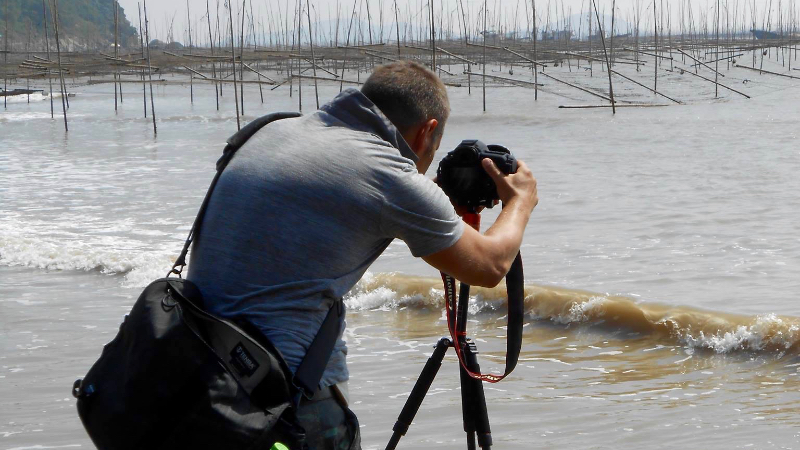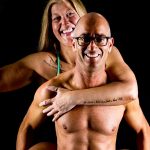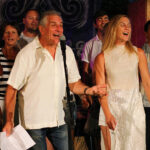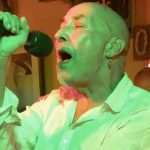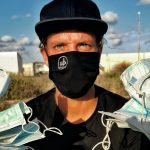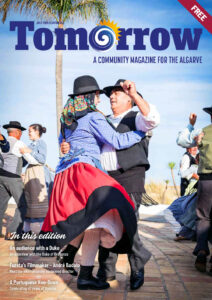By Stephanie Ginger
Alexandre Manuel and his search for simplicity
If you wander along Praia da Luz promenade almost any afternoon during the summer months, a small stall selling exquisite black and white photographs of the Algarve will undoubtedly catch your eye.
The stall belongs to Portuguese photographer Alexandre Manuel and a few years ago I bought one of Alexandre’s high-quality prints – a tempestuous study of a raging sea at Sagres – as a present for my brother. Since then, I’ve wanted to talk to the man behind these fine art pictures which show a truthful side to the Algarve that most summer visitors, let’s be honest, would not be aware of otherwise.
So here I am on a blistering July afternoon in the shade of a canopy behind his display. With one eye on passing trade and the sound of the seashore in our ears, he tells me about his life and his art. I quickly realise that, like his extraordinary award-winning photos, Alexandre, with his ready smile and lilting French accent, is anything but ordinary.
For starters, what I didn’t expect is that photography is Alexandre’s second career. His first was as an academic in Semiotics and Linguistics. He was brought up in a close family from the far eastern Algarve on the Guadiana River; his mother from the little village of Castro Marim just outside Vila Real de Santo Antonio and his father from Monte Gordo. Following school, he went to the University of Besançon, in north-eastern France to study Semiotics, a philosophical approach that seeks to interpret messages in terms of signs and patterns. These signs can be linguistic, i.e. in a word or a sound or they can be visual, within images.

“I spent many years in France,” he explains, first gaining a degree, then a Masters. “My specialism was visual semiotics,” he explains: the analysis of visual images and how they communicate a particular message. Following that, he then went on to do a PhD in the visual semiotic study of TV News. “For that, I had to analyse big dramatic events reported on the TV such as Nine Eleven and the Tsunami (in Thailand) of 2004-5.”
For a decade between 2000 and 2010, Alexandre watched and recorded television news, analysing the differences between American, French and Portuguese methods of reporting disasters; how they build emotions and drama.
By 2010, he had returned to Portugal to teach Semiotics at Faro University and Linguistics and French at the Lyceum. And it was about this time that his innate urge to do something else, something artistic, began to take hold.
So what made him take that leap into the landscape, as it were? Did he wake up one day thinking he’d had enough studying pain and anguish and it was time to do something else?
“Something like that,” he admits, hand on heart. “It was always inside me, the dream to do something artistic. I spent every day for years studying real-life drama in which people die, I wanted to do the opposite. I wanted to create something beautiful. Something simple. With no people.” He grins. “I used to tell my colleagues as a joke ‘One day, I’m going to change everything. Do something for myself. Maybe I’m going to be an artist or maybe I’ll just make soap!’”

Soap turned out not to be an option, but the lure of the lonely landscape gradually drew him in and finally, he resigned from teaching and took the risky decision to indeed “change everything” and make photography his career.
And did his decision to throw up a respected academic career for the precarious existence of a fine art photographer cause conflict within his family?
“It was very bad in the beginning,” he admits ruefully. “When I got my PhD my family were so very proud – particularly as I had the best results in my year. They just didn’t understand! But now they are very supportive and are very proud of what I’ve achieved. They even help me with publicity.”
Until a few years ago, Alexandre used analogue photography, printing the black and white and Sepia prints himself. These days, however, the increasing scarcity and expense of the analogue system, as well as improvement in digital equipment, means that he now works almost exclusively in digital media and has his work printed in Albufeira to ensure it is of the highest standard.
Digital photography does not necessarily mean less gear to carry around, however; with at least a camera, tripod, lenses, shutter delay, filters and a remote.
So where does he begin?
“A good photograph is a moment in time,” he explains. “For me, I can get inspiration from anywhere; a postcard, a book or maybe even from Google maps. I see some potential and I get ideas from that.”

“Weather is very important,” he says. “Winter has a kind of purity and I’m always trying to extract the beauty and wildness in a landscape. I hardly ever take photographs in summer. Unlike most people in Portugal, I don’t like the sun. Summer light is too strong. The irony is you could call me ‘Mr. Sunshine’ because everywhere I go the sun seems to shine!”
And does he recognise a great picture straightaway? “Technique is important and I spend a lot of time on composition and calculating the light, for example, but it’s not just about technical skill. It’s an emotional connection between me and the picture. Sometimes it’s an instant thing, but then again at other times it’s like music; the more you listen to it, the more you love it. A good photograph can be like that. Each time you look at it, you see something else.”
“It can be very frustrating too,” he admits. “Occasionally, when I’m travelling, for example, I know exactly what I want and when I get there, the conditions are not right.”
This happened on his recent visit to China “There were two mountains. One range of mountains in Huangshan, I managed to get a photograph I really like (pictured), but I climbed another mountain range Zhangjiajie for four hours, something like six thousand steps and got nothing because of the weather! Not one picture!” He laughs. “But I like to be positive, so I look at the week I spent there as being useful for next time because now I know exactly where to go.”

It’s hard to make a living solely from artistic photography, but it’s clear Alexandre is on the right track; In the last few years, he’s won or been placed in a number of prestigious international awards for fine art, architecture and landscape photography, including European (Landscape) Professional Photographer of the Year 2015.
And his talent is by no means confined to Portugal. This year alone, he’s travelled to China, Vietnam, Japan and Iceland to take photos and he is represented by the Adega Gallery in Lagoa, Sâo Mamede in Lisbon as well as galleries in Lugano, Switzerland and Sâo Paulo, Brazil.
And for the future?
Alexandre replies with a bright smile. “I’ll keep going, of course! I want to return to China in the winter and finish what I started. I’d like to produce a book of my photos to show to the galleries. The most important thing is that I’m doing what I love.”
Until then you can find Alexandre and his work on the promenade at Luz and in Mar D’Estorias in Lagos, an important outlet giving much-needed support to local artists and artisans. There’s no doubt though, that what he’d really like is for more international galleries to take him on so that he can get out on the road and concentrate on what he does best. Taking the perfect picture.
